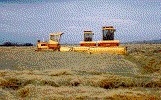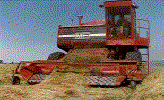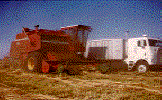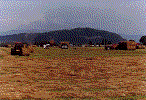Growing and Harvesting
Oregon Ryegrass
Growing Ryegrass, like most farming ventures, is a matter of skill,
persistence, patience and luck. A brief description is provided here for
general information about raising the raw material resource of the Meadowood
products. Additional information may be obtained from Oregon State
University and various grass seed related organizations.
Annual ryegrass is usually planted in the fall soon after the previous crop
is removed. The soil is first tilled to prepare a seed bed that will reduce
competition from undesirable plants. Care is taken to help the new crop get established by supplementing the soil nutrients and by
farming practices
that reduce the chance for disease or weeds to injure the seedlings. The
fall and winter rains provide the famous Oregon moisture that makes this crop so
well suited to the Willamette Valley climatic conditions.
Some growers work
with sheep herders to control the growth rate and vigor of the plants by
providing pasture for fattening lambs. Additional fertilizer, weed,
disease and insect
control measures may be employed during the winter and spring. By late
June or early July, the
crop is usually ready to swath into windrows to help the seed ripen more
evenly and avoid shatter of seed from the stem while it dries before harvest.
Self propelled combines pick up the windrows, thrash the seed
from the ryegrass stems and place the seed in a truck for transport to the
storage warehouse. Care of the straw behind the harvester is determined by the method that will be
used for removal. The straw may be allowed to drop back to the ground or attached devices
may spread or chop the straw as it leaves the
rear of the combine.
The seed from each field is segregated into lots and stored for any further drying.
After drying, the harvested seed is processed to remove undesirable
hulls, foreign or small seeds, parts of stems, and dirt before bagging. A tag is attached
as the seed is bagged, that will identify the seed lot so that each bag can be matched with
testing
information. Samples are taken from the cleaned bagged seed and tested to certify
both the purity and percentage of seeds that will germinate. A Seed
Certification Service is administered by Oregon State University to assure and
certify the quality of seed.
Oregon grass seed is generally marketed and distributed through commercial seed
companies that contract with or purchase from the growers.
 Self propelled swathers
cutting and placing ryegrass in windrows to ripen the seed more uniformly.
Self propelled swathers
cutting and placing ryegrass in windrows to ripen the seed more uniformly.
 Self-propelled combine picking up ryegrass from the windrow and threshing the
seed from the stems.
Self-propelled combine picking up ryegrass from the windrow and threshing the
seed from the stems.
 Off-loading ryegrass seed from the combine to the bulk truck for transport to the
seed warehouse.
Off-loading ryegrass seed from the combine to the bulk truck for transport to the
seed warehouse.
 Using a round baleing system to remove the ryegrass straw after harvest (or the
crop after spoilage
by mold in a wet year).
Using a round baleing system to remove the ryegrass straw after harvest (or the
crop after spoilage
by mold in a wet year).

Leonard Opel is one of the primary founders of
Meadowood Industries, Inc. He has been involved in the Oregon grass seed
industry most of his life as a producer, and as an active member and
officer of agricultural organizations. Leonard divides his time between
Meadowood and assisting his sons who have taken over the family farming operations and seed
business, LMO Farms, Inc.

Information Request Form

